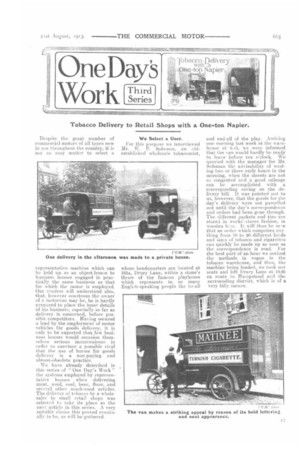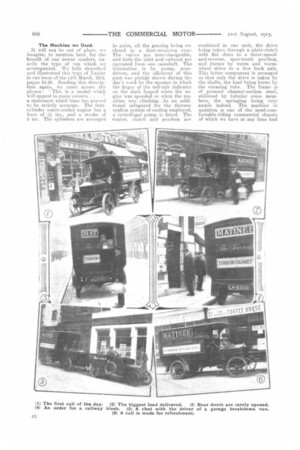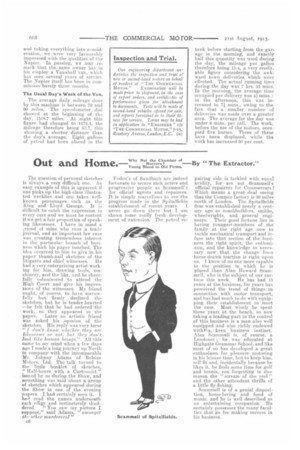Tobacco Delivery to Retail Shops with a One-ton Napier.
Page 9

Page 10

Page 11

Page 12

If you've noticed an error in this article please click here to report it so we can fix it.
Despite the great number of commercial motors of all types now in use throughout the country, it is not an easy matter to select a
representative machine which can be held up as an object-lesson to business houses engaged in practically the same business as that for which the motor is employed. Our readers will understand also, that, however courteous the owner of a motorvan may be, he is hardly prepared to place the inner details of his business, especially so far as delivery is concerned, before possible competitors. Having secured a lead by the employment of motor vehicles for goods delivery, it is only to be expected that -few business houses would occasion themselves serious inconvenience in order to convince a possible rival that the use of horses for goods delivery is a non-paying and almost-obsolete practice.
We have already described in this series of "One Day's Work" the systems employed by representative houses when delivering meat, wool, coal, beer, flour, and several other much-used articles. The delivery of tobacoo by a wholesaler to small retail shops was selected t take its place as the next article in this series. A very suitable choice this proved eventually to be, as will be gathered. We Select a User.
For this purpose we interviewed Mr. W. P. Solomon, an established wholesale wholesale tobacconist,
whose headquarters are located at 162A, Drury Lane, within a stone's throw of the famous playhouse which represents to so many English-speaking people the be-all
and end-all of the play. Arriving one morning last week at. the warehouse at 8. '1 5, we were informed that the van would hardly be ready to leave before ten o'clock. We queried with the manager for Mr. Soloman the advisability of wasting two or three early hours in the morning, when the streets are not so congested and a good mileage can be accomplished with a corresponding saving on the delivery bill. It was pointed out to us, however, that the goods for the day's delivery were not parcelled out until the day's morespondence and orders had been gone through. The different packets and tins are stored in works'-stores fashion, in wooden bins. It will time he se7111 that an order which comprises anything from 10 to 20 different kinds and sizes of tobacco and cigarettes can quickly be made up as soon as the correspondence is read. For the best part of an hour we noticed the methods in vogue in the tobacco warehouse, and then, the machine being loaded, we took our seats and left Drury Lane at 10.25 en route to Hampstead and the surrounding district, which is of a very hilly nature.
The Machine we Used.
It will not be out of place, we imagine, to mention here, for the benefit of our newer readers, exactly the type of van which we accompanied. We fully described and illustrated this type of Napier in our issue of the 14th March, 1912, pages 24-26. Reading this description again, we came across the phrase : " This is a model which will appeal to many owners . .
a statement which time has proved to be strictly accurate, The fourcylinder water-cooled engine has a bore of 31 ins., and a stroke of 5 ins. The cylinders are arranged in pairs, all the gearing being enclosed in a dust-retaining ease. The valves are inter changeable, and both the inlet and exhaust arc operated from one camshaft. The lubrication is by pump, geardriven, and the efficiency of this part was plainjy shown during the day's work by the manner in which the finger of the tell-tale indicator on the dash leaped when the engine was speeded or when the machine was climbing. As an additional safeguard for the therroosyphon system of cooling employed, a centrifugal pump is fitted. The engine, clutch and gearbox are
combined in one unit, the drive bring taken through a plate-clutch with flat discs to a three•speedand-reverse, spur-tooth gearbox, and thence by worm and wormwheel drive to a live back axle. This latter component is arranged so that only the drive is taken by the shafts, the load being borne by the encasing tube, The frame is of pressed channel-section steel, stiffened by tubular cross members, the springing being very .ample indeed. The machine in question is one of the most-comfortable-riding commercial chassis of which we have at any time had
experience. The brakes proved very efficient throughout the day, while me noticed that the control was very simple, and caused the driver not the slightest inconvenience, either in traffic or when running fairly free from the many London " hold-ups" and halts.
Small but Rapid Deliveries.
The morning's load consisted of 65 parcels, and the first delivery was to a small shop immediately adjoining St. Pancras station. Before the start the mileage recorder registered 1518.7 miles. The load was made up of cigarettes, tobacco in packets and tins, pipes, matches, and all the paraphernalia. usually stocked by the retail tobacconist_ A point we noticed was that, in consequence of the great attractiveness of this class of load to the loafer, it is only on very rare occasions that the tail doors on the van are opened, the usual procedure being for the boy to hand out the parcel to the driver, who carries it intothe customer's shop. When loading, the parcels last to be delivered are, of course, loaded into the van first, and so, almost without exception, there is no confusion in searching for the right parcel when the shop at the customer is reached.
Proof of Advertisement Value.
The business is divided up into credit and " T.P.",—shortly, " to pay"—and, owing to the fact that in many cases no delay is incurred by having to wait while the customer signs the receipt or finds the money, the average time occupied per call was comparatively small. Whilst in William Street, a little incident occurred which does much to emphasize the value of the modern motorvan as an advertisement medium. As we stood outside the shop of a customer, the driver was approached by. a small tobacconist from the other side of the street, who stated that he had often noticed the motorvan engaged in delivering to other shops, and, taking note of the regularity of its calls, he was impressed by the fact that the firm of Solomon could serve him much better than the wholesaler with whom he was then dealing. In our opinioe, this is most excellent testimony, and is an actual proof of that advertisement value which we have so con
sistently claimed over a period of years on behalf of the motorvan.
A Plea for a Self-starter.
Many of the shops at which we called were separated only by a very short distance, in some cases by not more than 30 yards, and owing to the fact that no great time was taken in effecting delivery in the majority of cases, it was hardly necessary to stop the engine. The work done during the day proved beyond doub( that some satisfactory form of selfstarter for motorva.ns is urgently needed. Merely as a petrol saver, the cost of this accessory would be repaid several times in a year. There was little of outstanding interest during the morning's work. The machine played its part in that necessarily-humdrum, routine busi
ness which keeps this great city of London on its commercial footing. It is the reliability of the thousands of similar business units which has built up the prosperity of the world's capital.
65 Calls in Four Hours.
For reasons into which we did not enter, two customers refused delivery of their parcels, both of which came under the " T.P.'' category. Accordingly, then, although 65 calls were made in all, only 63 deliveries were effected. We returned to the warehouse via Bloomsbury, and made our last delivery almost in Tottenham Court Road, The time of arrival at the warehouse in Drury Lane was 2.30 exactly. All the morning's work had been performed ia the near neighbourhood of Hampstead, the longest non-stop run during the morning being eight minutes.
A hurried lunch was then snatched, and at 3.15 we were once again on the way with a further load of 35 parcels to be delivered. On this occasion, our route lay through Lambeth, Norwood, Atterley, Sydenham, Forest Hill, and Brockley. The detail work was very similar to that done during the morning. The last delivery was made at 6.48, and at 7.5 we were back again in Drury Lane. After receiving instructions for the following day, the driver then took Ihe van to Kentish Town, a rmther journey of three miles to the garage.
The "No-Trouble' Machine.
As we have said, there was no sensational incident to record during the day's work. The van ran splendidly throughout the day. Stopping and starting on many occasions, it was the exception for the engine not to fire at the firstpull of the handle. The ease of steering and control is a fine tribute to the skill of the designer,
and taking everything into isensideration, we were very favourably impressed with the qualities of the Napier. In passing, we may remark that the same owner basin his employ a Vauxhall van, Arhich has seen several years of service. The Napier itself has been in commission barely three months.
The Usual Day's Work of the Van.
The average daily mileage done by this machine is between 70 and 90 miles. The speedometer dial showed at the beginning of the day, 1518.7 miles. At night this figure had changed to 1572.4, the mileage therefore being 53.7, this showing a shorter distance than the day's average. Eight gallons of petrol had been placed in the tank before starting from the garage in the morning, and exactly half this quantity was used during the day, the mileage per gallon therefore being 13.4, a very creditable figure considering the awkward town deliveries which were effected. The actual running time during the day was 7 hrs. 55 mine. In the morning, the average time occupied per delivery was 41 mine.: in the afternoon, this was increased to 71 mins., owing to the fact that a. smaller number of deliveries was made over a greater area. The average for the day was under 6 mins. per call. The work, before the use of the motors, occupied five horses. Three of these have been displaced, while the work has increased 50 per cent.




















